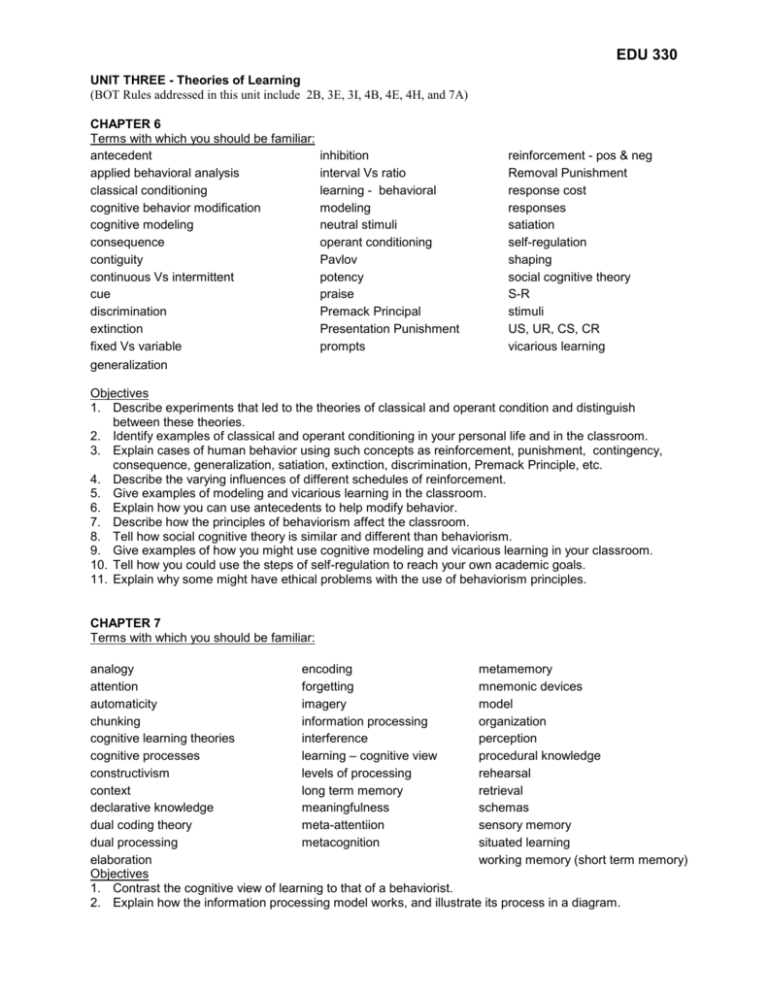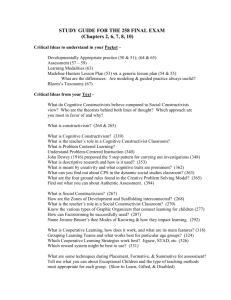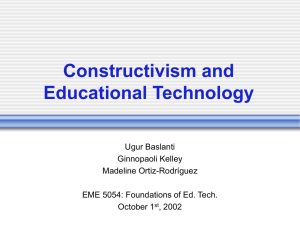Unit 3 Study Guide
advertisement

EDU 330 UNIT THREE - Theories of Learning (BOT Rules addressed in this unit include 2B, 3E, 3I, 4B, 4E, 4H, and 7A) CHAPTER 6 Terms with which you should be familiar: antecedent applied behavioral analysis classical conditioning cognitive behavior modification cognitive modeling consequence contiguity continuous Vs intermittent cue discrimination extinction fixed Vs variable generalization inhibition interval Vs ratio learning - behavioral modeling neutral stimuli operant conditioning Pavlov potency praise Premack Principal Presentation Punishment prompts reinforcement - pos & neg Removal Punishment response cost responses satiation self-regulation shaping social cognitive theory S-R stimuli US, UR, CS, CR vicarious learning Objectives 1. Describe experiments that led to the theories of classical and operant condition and distinguish between these theories. 2. Identify examples of classical and operant conditioning in your personal life and in the classroom. 3. Explain cases of human behavior using such concepts as reinforcement, punishment, contingency, consequence, generalization, satiation, extinction, discrimination, Premack Principle, etc. 4. Describe the varying influences of different schedules of reinforcement. 5. Give examples of modeling and vicarious learning in the classroom. 6. Explain how you can use antecedents to help modify behavior. 7. Describe how the principles of behaviorism affect the classroom. 8. Tell how social cognitive theory is similar and different than behaviorism. 9. Give examples of how you might use cognitive modeling and vicarious learning in your classroom. 10. Tell how you could use the steps of self-regulation to reach your own academic goals. 11. Explain why some might have ethical problems with the use of behaviorism principles. CHAPTER 7 Terms with which you should be familiar: analogy encoding metamemory attention forgetting mnemonic devices automaticity imagery model chunking information processing organization cognitive learning theories interference perception cognitive processes learning – cognitive view procedural knowledge constructivism levels of processing rehearsal context long term memory retrieval declarative knowledge meaningfulness schemas dual coding theory meta-attentiion sensory memory dual processing metacognition situated learning elaboration working memory (short term memory) Objectives 1. Contrast the cognitive view of learning to that of a behaviorist. 2. Explain how the information processing model works, and illustrate its process in a diagram. EDU 330 3. 4. 5. 6. 7. 8. Contrast sensory, working (short term), and long term memories with respect to capacity and duration. Give examples of cognitive processes and explain their role in learning. Describe several ways in which memory strategies can be directly taught. Use an example to illustrate the 3 stages of acquiring procedural knowledge. Explain why two individuals’ perceptions of the same event can differ. Describe several ways you can help make information meaningful for students. CHAPTER 8 Terms with which you should be familiar: cognitive constructivism inquiry reciprocal questioning constructivism Jigsaw II scripted cooperation cooperative learning learner-centered instruction social constructivism guided discovery real-world task STAD 1. Identify the essential elements of constructivist views of learning - including the four characteristics constructivists say permeate all learning. 2. Describe the implications that constructivism has for the teacher. 3. Give several suggestions to a teacher who wants to use constructive methods. 4. Explain how Piaget and Vygotsky differ in their views of constructivism. 5. Tell why a constructivist would object to a behaviorist’s method of teaching. 6. Explain how guided discovery, inquiry, discussion, and cooperative learning are constructivist approaches. 7. Identify several characteristics of cooperative learning. 8. Describe 2 forms of cooperative learning. 9. Give an example of how you could use guided discovery in your classroom. How about the inquiry method? CHAPTER 9 Terms with which you should be familiar: algorithm elaborative questioning characteristics exemplars cognitive apprenticeship comprehension monitoring concept mapping concepts critical thinking drawing analogies expert v. novice prob solver general & specific transfer heuristics means-ends analysis metacognition positive & negative transfer problem-based learning problem - well-defined Vs illdefined prototype rule-example situated learning PQ4R Objectives 1. Define concept learning and describe several things that can be used to facilitate concept learning. 2. Outline the steps in problem solving and list some general suggestions that may be helpful to your students in solving problems. 3. Describe how experts and novices differ in their problem solving. 4. Describe how the constructivist approaches problem solving. 5. Contrast use of strategies to concept learning and problem solving. 6. Give some examples of study strategies you can suggest to your students. 7. Tell how you can help your students to think critically. 8. Keeping in mind the factors that affect transfer of learning, tell how you can help your students transfer their learning. EDU 330 OTHER Terms with which you should be familiar: aversive intrinsic Vs extrinsic contingency massed Vs distributed practice interference overlearning retroactive Vs proactive rote Vs meaningful serial position effect Objectives 1. State what the case of Phineas Gage told us about memory. 2. Cite the manner in which the Penfield studies indicate that memories are stored. 3. Identify some things that the one-eyed cat studies told us about the interrelationships of the two hemispheres of the brain in learning and when transfer between hemispheres occurs. 4. Describe the McConnell study, what he meant by incubation, and possible implication for learning. 5. List 5 suggestions mentioned in class for helping students process information for memory.









